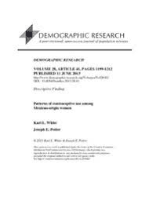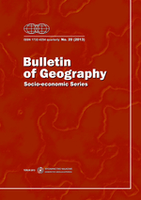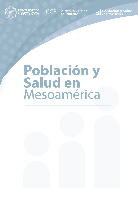
Novedades en Poblacion
Scope & Guideline
Advancing Knowledge in Demographic Studies
Introduction
Aims and Scopes
- Demographic Analysis and Trends:
The journal consistently publishes research that analyzes demographic trends, such as aging populations, fertility rates, and migration patterns, particularly within Cuba and other Latin American contexts. - Social and Health Issues:
There is a strong emphasis on the intersection of population studies with health issues, including reproductive health, chronic diseases, and the impact of public health crises such as COVID-19. - Migration and Mobility:
The journal explores various dimensions of migration, including internal migration, international migration, and its socio-economic impacts, highlighting the experiences of Cuban emigrants and their families. - Socioeconomic Dynamics:
Research often delves into the socio-economic characteristics of populations, including studies on poverty, gender dynamics, and inequalities, reflecting the socio-political context of Cuba. - Interdisciplinary Approaches:
The journal encourages interdisciplinary methodologies, integrating perspectives from sociology, public health, economics, and communication to provide comprehensive insights into population issues.
Trending and Emerging
- Impact of COVID-19 on Populations:
A significant number of recent publications focus on the effects of the COVID-19 pandemic on various demographic groups, exploring health, social, and economic implications. - Aging and Elderly Care:
Research into the challenges and dynamics of aging populations is on the rise, addressing issues such as health care, social support systems, and the socio-economic implications of an aging society. - Migration and Geopolitics:
Emerging themes include the analysis of migration patterns in the context of geopolitical changes, particularly relating to Cuban migration to the United States and the socio-political implications. - Gender and Demography:
There is an increasing focus on gender-related studies within population research, examining the roles and impacts of gender in migration, health, and social dynamics. - Social Inequality and Vulnerability:
Recent trends show a heightened interest in exploring social inequalities and vulnerabilities among different demographic groups, particularly in relation to health outcomes and access to services.
Declining or Waning
- Historical Population Studies:
Research focusing on historical demographic trends and events has decreased, with fewer studies examining past population dynamics or comparisons with contemporary issues. - Environmental Impact Studies:
There appears to be a waning emphasis on environmental factors affecting population health and dynamics, with fewer articles linking ecological changes directly to demographic outcomes. - Rural Demographics:
The focus on rural population studies has diminished, as more recent publications have shifted towards urban populations and metropolitan dynamics, reflecting changing research priorities. - Child and Adolescent Studies:
Although still significant, research specifically targeting child and adolescent demographics has become less frequent, with fewer publications focusing exclusively on these age groups in recent issues. - Policy Evaluation Studies:
There is a noticeable decrease in articles critically evaluating past and current population policies, suggesting a shift towards more immediate demographic issues rather than long-term policy analysis.
Similar Journals

JOURNAL OF POPULATION RESEARCH
Advancing demographic insights for a changing world.JOURNAL OF POPULATION RESEARCH, published by Springer, is a premier journal dedicated to advancing the field of demographic studies. With a focus on research that addresses the complexities of population dynamics, this journal serves as a vital platform for scholars, practitioners, and students alike. It holds a commendable Q2 ranking in the Demography category for 2023, underscoring its influence and commitment to quality research. The journal spans a rich convergence of knowledge from 2005 to 2024, covering key developments and emerging trends in population research. Although it operates under a traditional access model, its impact continues to resonate throughout the academic community, highlighting the importance of robust demographic analysis in policy and planning. By fostering insightful discussions and providing access to groundbreaking studies, the JOURNAL OF POPULATION RESEARCH remains an essential resource for those eager to deepen their understanding of population issues.

Migraciones
Advancing Knowledge on Global MobilityMigraciones, an esteemed academic journal founded in 2012 and published by the UNIV PONTIFICIA COMILLAS MADRID, FAC FILOSOFIA, serves as a vital resource in the fields of Cultural Studies and Demography. With a commendable Q1 ranking in Cultural Studies and a strong presence in Demography (Q2), this journal boasts a significant impact in facilitating scholarly discourse and empirical research in migration issues. The journal has embraced an Open Access model since 2016, providing unrestricted access to its rich array of scholarly articles that critically examine the cultural implications and demographic dynamics of migration patterns globally. Migraciones not only showcases rigorous peer-reviewed research but also encourages interdisciplinary studies, making it an essential publication for researchers, professionals, and students seeking to deepen their understanding of migratory phenomena. For those interested, the journal is accessible under ISSN 1138-5774 and E-ISSN 2341-0833, based in Madrid, Spain.

Demographic Research
Advancing insights into demographic dynamics.Demographic Research is a leading journal in the field of demography, published by the prestigious Max Planck Institute for Demographic Research. Available in both print and electronic formats (ISSN: 1435-9871, E-ISSN: 1435-9871), this open-access journal has been a valuable resource for demographers and social scientists since its inception in 1999. With a commendable impact factor and ranked Q1 in its category, the journal demonstrates a significant commitment to advancing our understanding of demographic trends and their implications across contexts. Hailing from Germany, the journal's rich international perspective adds depth to its studies, making it a vital platform for innovative research. Researchers, professionals, and students are encouraged to engage with its wealth of articles that not only document demographic changes but also offer insights critical for policy-making and social planning. The journal's broad scope encompasses diverse themes, providing a comprehensive overview of the demographic shifts that shape societies today.

Population Review
Navigating the Complexities of DemographyPopulation Review, published by Sociological Demography Press, is a vital resource in the field of demography, contributing to the understanding of population dynamics and trends since its inception in 1988. With an ISSN of 1549-0955 and an E-ISSN of the same number, the journal has played a significant role in disseminating scholarly research and analysis relevant to demographic changes and their implications. Although currently categorized in the Q4 quartile, it ranks 78th out of 139 in the Scopus Social Sciences: Demography category, placing it within the 44th percentile among its peers. This journal serves as a platform for researchers, professionals, and students to engage with contemporary population issues, encouraging the exploration of new theories and methodologies. While not available as open access, its robust editorial standards and commitment to rigorous research make it an invaluable addition to the libraries of demographers and social scientists alike.

Bulletin of Geography-Socio-Economic Series
Exploring the dynamic interplay of geography and socio-economics.Bulletin of Geography-Socio-Economic Series, published by Nicolaus Copernicus University in Torun, Poland, is a premier Open Access journal dedicated to enhancing interdisciplinary discourse within the fields of geography and socio-economics. Since its inception in 2003, the journal has garnered significant recognition, achieving a Q1 ranking in Cultural Studies and notable placements in other categories, affirming its impact on the academic community. The journal provides valuable insights and research findings with the aim of fostering a deeper understanding of socio-economic trends and their geographical implications. Its commitment to Open Access since 2008 underscores its dedication to disseminating knowledge widely, making it an essential resource for researchers, professionals, and students alike. With an accessible online format and a solid reputation reflected in its impressive Scopus ranks, the Bulletin of Geography-Socio-Economic Series plays a pivotal role in shaping contemporary discussions in social sciences, facilitating knowledge exchange across borders.

JOURNAL OF POPULATION ECONOMICS
Pioneering Research at the Intersection of Demography and EconomicsThe JOURNAL OF POPULATION ECONOMICS, published by SPRINGER, stands as a leading peer-reviewed journal in the fields of demography and economics. Established in 1988, this esteemed journal offers a platform for high-quality research that probes the intricate relationships between population dynamics and economic phenomena. With its impressive Q1 quartile ranking in both Demography and Economics and Econometrics for 2023, the journal is recognized as a vital resource for scholars and practitioners alike, reflecting its rigorous standards and impact in the academic community. Its Scopus rankings position it within the top tiers of social sciences, making it an essential read for those engaged in demographic and economic research. Although the journal does not currently adopt an open access model, its esteemed reputation and continuous publication until 2024 ensure relevant and up-to-date findings contribute meaningfully to scholarly discourse. At its core, the JOURNAL OF POPULATION ECONOMICS aims to bridge theoretical insights and empirical findings, fostering an understanding of how population changes influence economic outcomes and vice versa.

Biodemography and Social Biology
Advancing Insights into Human Population DynamicsBiodemography and Social Biology is a distinguished academic journal published by Routledge Journals, Taylor & Francis Ltd, focusing on the intersections of demographic and biological sciences. With its ISSN 1948-5565 and E-ISSN 1948-5573, this journal contributes significantly to the fields of anthropology, demography, and social biology, making it an essential resource for researchers and professionals alike. The journal has consistently achieved high rankings, notably placing in Q2 in both anthropology and demography, underlining its impact in these critical areas of study. Although it does not provide Open Access options, the journal's rigorous peer-review process ensures the highest quality of academic discourse and research dissemination. Covering a wide scope of topics related to human population dynamics, health, and behavior, Biodemography and Social Biology serves as a vital platform for advancing knowledge and understanding of the biological and social factors influencing human societies since its inception in 1990. Researchers, students, and professionals are invited to contribute their findings and insights, enriching the academic conversation that this journal fosters.

DEMOGRAPHY
Uncovering the patterns of our collective existence.DEMOGRAPHY is a prestigious, peer-reviewed journal published by DUKE UNIVERSITY PRESS, dedicated to advancing the field of demography through scholarly research and critical discourse. With an esteemed Q1 ranking in Social Sciences and an impressive Scopus rank of #10 out of 139 in the category, this journal holds a 93rd percentile status, reflecting its significant impact on the academic community. Covering a wide range of topics related to population studies, including fertility, mortality, migration, and demographic change, DEMOGRAPHY serves as a vital resource for researchers, professionals, and students alike. Since its inception in 1964, it has provided a platform for innovative studies and influential articles that address both theoretical frameworks and applied research. Although not an open-access journal, it ensures that its contributions reach a global audience while maintaining rigorous academic standards. Engage with DEMOGRAPHY to explore and contribute to the dynamic discussions shaping our understanding of human populations in a complex world.

Poblacion y Salud en Mesoamerica
Unveiling Insights into Mesoamerican Health and PopulationPoblacion y Salud en Mesoamerica is a pivotal open-access journal published by the University of Costa Rica's Centro Centroamericano Poblacion. With an ISSN of 1659-0201 and an E-ISSN of the same, this journal has been dedicated since 2003 to advancing the fields of demography, epidemiology, health informatics, and public health within the Mesoamerican region. Addressing critical health and population issues, it aims to foster a deeper understanding of demographic trends and their implications on health policies. As of 2023, the journal ranks in the Q4 quartile across several categories, reflecting its commitment to publishing quality research while serving as a platform for emerging scholars and seasoned professionals alike. Although it is currently in the lower quartile ranks, the journal seeks to establish itself as a vital resource in the context of Mesoamerican social sciences and health, making it an essential tool for researchers and practitioners interested in regional population health dynamics. Its editorial board is comprised of experts dedicated to enhancing the scholarly conversation surrounding population health and policy in Central America.

Journal of Demographic Economics
Exploring the Nexus of Population and EconomyThe Journal of Demographic Economics, published by Cambridge University Press, stands as a leading interdisciplinary platform dedicated to the exploration and advancement of research in the intertwined fields of demography, economics, and geography. With an impact factor that reflects its esteemed position—ranking in the Q1 quartile for Demography (2023)—the journal fosters scholarly dialogue through high-quality articles that elucidate the complex interactions between population dynamics and economic trends. Operating under an open access model, the journal ensures that its findings are widely accessible, promoting inclusivity and engagement among researchers, professionals, and students alike. The Journal of Demographic Economics endeavors to bridge gaps in knowledge by publishing innovative and rigorous studies, thereby contributing significantly to both theoretical frameworks and practical applications across various domains. Drawing submissions from a global audience, this journal not only enhances the understanding of demographic transitions but also informs policy decisions and socioeconomic development strategies, making it an essential resource for those invested in demographic and economic research.